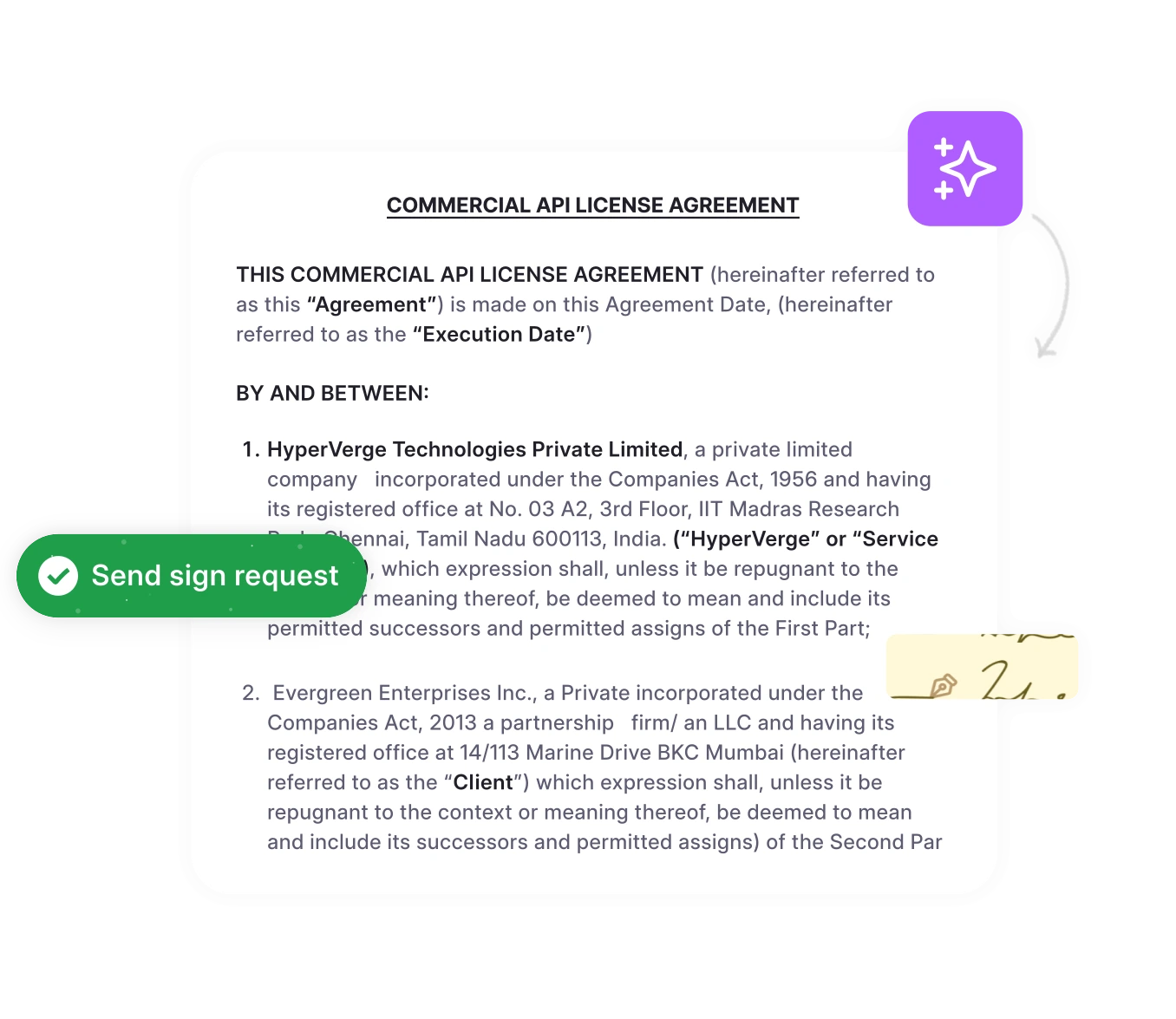The indemnification clause is usually one of the most negotiated clauses that determines who pays when things go wrong.
In this guide, we’ll break down what it is, why your standard limit of liability might not protect you, and how to spot hidden risks without having to read through the fine print every time.
What is an indemnification clause?
The indemnification clause is a contractual promise where one party agrees to cover the financial losses of another if specific harmful events occur. It’s essentially a risk transfer mechanism, shifting the burden of potential legal costs, damages, and liabilities from one party to another.
At its core, an indemnity provision requires the indemnifying party to take on defense costs directly or through reimbursement of legal fees and damages for losses the indemnified party incurs for something arising under the contract. Third-party claims for intellectual property infringement are a common example.
Standard limits of liability clauses often don’t restrict indemnity obligations in contracts because courts treat indemnities for third-party claims as performance duties to defend, settle, or pay. This means, even a carefully negotiated liability cap bears no consequence to such a clause.
Read also, your limit of liability might not work on your indemnity.
The better approach? Explicitly cap the indemnitor’s obligations. For example, set a maximum spend on defense, settlements, or judgments. For example, LeadSquared uses HyperStart’s AI to instantly flag uncapped indemnity clauses in vendor agreements, preventing unlimited liability exposure.
Red-flag
First-party indemnification clauses. These provisions require you to indemnify the other party for bringing a lawsuit against you for something you did. Keep indemnification expressly limited to third parties.
Indemnification vs. Hold harmless: Are they the same thing?
While these terms are often used interchangeably, there’s a subtle difference.
Indemnification primarily focuses on reimbursing for financial losses. It’s about making the other party whole after they’ve suffered damages, covering legal fees, settlements, and judgments.
Hold harmless primarily protects against legal liability itself. It prevents one party from being held legally responsible in the first place.
| Aspect | Indemnification | Hold Harmless |
| Primary purpose | Financial reimbursement | Protection from liability |
| Focus | Compensating after loss occurs | Preventing legal responsibility |
| Common use case | Third-party IP infringement claims | Preventing lawsuits from reaching the indemnified party |
Don’t get lost in the fine print
Standardize, track, and manage complex clauses across all your contracts.
Book a DemoBreaking down the clause
The “who”: Identifying the parties
Before you assess risk, know who’s protecting whom. In vendor agreements, customers typically want to be the indemnified party, while vendors push back on broad indemnity obligations.
The “what”: The scope of indemnification obligations
The scope determines the specific events, claims, or damages that trigger indemnification. Common scenarios include:
- Breach of contract: When one party fails to meet contractual obligations
- Negligence: Careless actions cause harm to third parties
- Intellectual property infringement: Violating someone’s patent, copyright, or trademark
- Data breaches: Compromised confidential information
- Property damage or death: Physical harm caused by one party’s actions or products
The narrower the scope, the less risk the indemnifying party assumes. As in-house counsel, you’ll spend significant time negotiating which risks fall within the indemnity clause.
The “how”: Procedures and limitations
A well-drafted indemnification clause should include:
- Notice requirements: How quickly must the indemnified party notify of a claim?
- Control of defense: Who gets to choose legal counsel?
- Settlement authority: Can the indemnifying party settle without consent?
- Cooperation obligations: What level of assistance must each party provide?
- Caps on liability: Are there dollar limits on cost?
Applying the indemnification
In service agreements
The indemnification clause states that the marketing agency will cover any legal costs if the client gets sued for copyright infringement in that content. The agency is transferring the risk of plagiarism claims to itself, a reasonable allocation since it controls content creation.
In real estate leases
A commercial tenant indemnifies the landlord against damages caused by the tenant’s guests or employees. Conversely, if a visitor injures themselves due to the tenant’s negligence, the tenant covers the legal defense and any settlement.
In software and tech contracts
A SaaS provider indemnifies customers against intellectual property infringement claims arising from use of the software. If a competitor alleges the software infringes their patent, the provider defends the customer and pays any resulting judgment. This is one of the most heavily negotiated provisions in technology agreements.
Parties tend to spend considerable time negotiating which party owes what to the other and for what. They may also choose to pull back damages excluded in the limitation of liability clause.
Master your contract management
See how HyperStart’s platform makes it easy to manage risk and streamline your entire contract lifecycle.
Book a DemoOne-sided vs. mutual indemnification agreement: Who protects whom?
One-sided indemnification
In unilateral indemnification, only one party protects the other. This is common in standard service agreements where the service provider indemnifies the customer against risks like IP infringement or data breaches.
Vendors often include one-sided indemnification clauses in their favor in standard contract terms and conditions. As in-house counsel, you can choose to flip the script.
Mutual indemnification
In mutual indemnification, both parties agree to protect each other for specific, predefined risks. This arrangement is typical in partnerships, joint ventures, or agreements between parties of relatively equal bargaining power.
Each party typically indemnifies the other for:
- Breach of their own representations and warranties
- Violation of laws or regulations by their own personnel
- Claims arising from their own negligence or willful misconduct
- IP infringement by their own products or services
The key is ensuring the risks are clearly delineated so each party assumes responsibility for risks within their control.
Why negotiating this clause is important.
Standard protections don’t cut it.
The hidden risks of a poorly written clause
Standard limit of liability clauses often don’t cap indemnity obligations, especially for third-party claims. Indemnities are performance duties (defend, settle, pay) rather than liability for breach.
This creates risky scenarios:
Scenario 1: A contract has a $500,000 limit of liability that bears the facade of protection. But when a third-party IP claim arises, one discovers that the indemnity obligation isn’t subject to that cap. Defense costs alone exceed $1 million before trial.
Scenario 2: The limit of liability might cap partial costs like judgment payments but not defense. You thought you had a $500,000 maximum exposure, but you’re actually responsible for unlimited defense costs plus a $500,000 judgment.
Scenario 3: To invoke the limit of liability, a vendor might be required to breach the indemnity, defeating the purpose. The indemnitor must refuse to defend or pay, triggering a separate breach claim, before the liability cap applies. This creates a lose-lose situation.
Scenario 4: You carefully excluded consequential damages from your contract. But consequential damage exclusions are usually irrelevant to indemnities since they govern inter-party, not third-party damages.
Read also, Contract Clauses Explained
The solution: Explicit indemnity caps
Instead of relying on your general limit of liability, use direct language in the indemnification clause itself:
“Indemnitor is not required to spend more than $[X] pursuant to Section __ (Indemnity), including without limitation on attorneys’ fees, court costs, settlements, judgments, and reimbursement of costs.”
This approach restricts the indemnitor’s obligation to perform, regardless of how courts interpret “liability” in your jurisdiction. You have written protection.
Is risk management possible at scale?
If you’re managing ten contracts, manually tracking indemnification obligations is tedious.
The challenge multiplies when you consider:
- Different indemnity scopes across vendors
- Varying caps and procedures
- Renewal dates when clauses should be renegotiated
- M&A activity that changes which entities are covered
- Insurance requirements tied to indemnification obligations
Without proper contract lifecycle management, you’re flying blind on risk exposure across your entire contract portfolio. CLM platforms like HyperStart solve this. Qapita’s legal team automatically tracks indemnity obligations and renewal dates across thousands of contracts from a single dashboard.
Practical negotiation tips for in-house counsel
Review and identify risks
When reviewing any contract, systematically identify risks related to:
- Indemnity scope: Are you indemnifying for the other party’s negligence?
- Liability caps: Does your general limit of liability exclude indemnities?
- Termination provisions: Do your indemnity obligations survive termination? For how long?
- Exclusivity requirements: If you’re granting exclusivity, what happens if the other party breaches?
Suggest balanced revisions
When the other side presents a one-sided indemnification clause, try language like:
“[Company] shall indemnify, defend, and hold harmless [Customer] from third-party claims arising solely from [Company]’s breach of this Agreement, provided that [Company]’s total defense and settlement spend shall not exceed [2x the annual contract value]. [Company] shall not indemnify [Customer] for claims arising from [Customer]’s negligence, willful misconduct, or breach of this Agreement.”
This revised clause:
- Limits exposure to third parties (no first-party indemnification)
- Excludes the other party’s own misconduct
- Caps total spend explicitly
- Ties the cap to a reasonable multiple of contract value
Watch for common limitations
Courts generally won’t enforce indemnification clauses that attempt to indemnify a party for their own gross negligence or willful misconduct. Some jurisdictions prohibit such clauses by statute, particularly in construction contracts.
Other common limitations include:
- Indemnification for criminal acts
- Overly broad or vague language
- Clauses that violate public policy
- Provisions that attempt to disclaim all liability in consumer contracts
Read also, I Know It’s Only Boilerplate (But I Like It)
The bottom line
Protect your company with better contract management. Indemnification clauses represent an important exposure point in commercial agreements.
The key takeaways:
- Your general limit of liability probably doesn’t cap indemnity obligations
- Explicitly limit indemnity performance with specific caps
- Keep indemnification expressly limited to third parties
- Exclude indemnification for the other party’s negligence or willful misconduct
- Establish clear procedures for notice, defense, and settlement
Even if you negotiate perfect indemnification clauses, managing them across hundreds or thousands of contracts is nearly impossible without the right tools. You need visibility into your risk exposure, automated alerts when claims arise, and the ability to quickly locate relevant provisions.
With the right CLM platform, you can track every indemnification obligation, monitor exposure across your entire contract portfolio, and ensure you’re always protected.
Take control of your contract risk
Track exposure, reduce risk, and streamline your entire contract lifecycle.
Book a Demo











